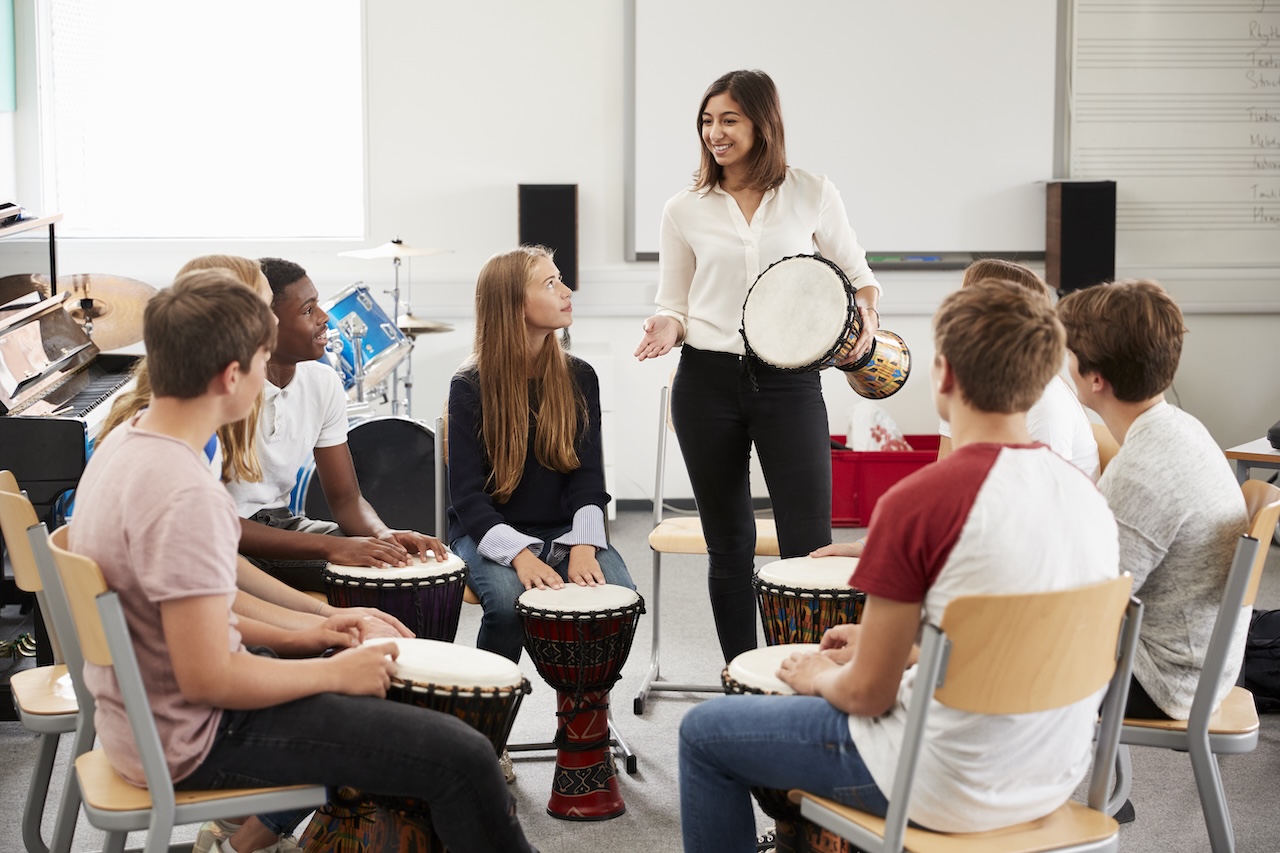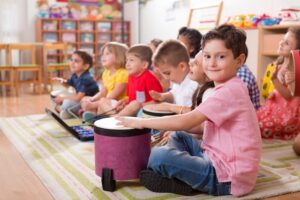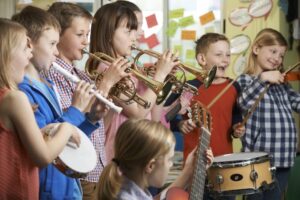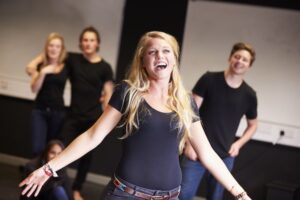Main Street News

Rocktober Feature: PPCSD Music Programs
This is the third feature in our Rocktober series, dropping every Saturday in October. This week, we chatted with the music teachers at the Pine Plains Central School District about their current curriculum, bouncing back from the pandemic, the importance of music education, and inspiring confidence and creativity in their students.
Building the foundation
Amanda Pollizatto teaches general music and chorus from pre-k through fifth grade, and at this level, music education is all about exploration and getting to move around.
In pre-k, Amanda said that the goal is to maintain a beat, while in kindergarten, students expand upon this and start to identify steady rhythms, fast versus slow beats, and high versus low beats. In first grade, the addition of singing is brought in, and students also start to learn to read music notes. At the second grade level, students keep building upon that foundation and learn to read more notes and about form.
 “They start to be able to recognize that the first part sounds different from the second part, but the third part sounds the same as the first part,” she said.
“They start to be able to recognize that the first part sounds different from the second part, but the third part sounds the same as the first part,” she said.
They also start to compose their own songs in the second grade. Amanda gives them rhythm blocks that they can put into whatever order they choose, then they explain why they chose that order and later, will perform their songs as well.
“It’s so cool to see them in pre-k when they’re in their shell and kind of staring at you with a blank face and like you’re crazy, and then as they move up through the grades they start doing little things and come out of their shell more,” Amanda said. “Then by the time they’re in fifth grade, they’re ready to go and know the routine. It’s so cool to watch that development and that growth happen.”
The importance of music education
All of the music teachers agree that music education is important in more ways than one. Amanda notes that while it’s beneficial to academics, music education also plays a big role in the socio-emotional well-being of students.
“It’s not discussed as often, but it really benefits them to give them a break from sitting at the desk. They get to move around, get creative, and think of things outside the box.”
Alec Sisco, who teaches sixth through twelfth grade chorus and general music, as well as the second half of music theory, said that the music program has been a huge help for a lot of the students, particularly coming back to school after the pandemic. “Music classes and ensemble classes are sometimes the only classes where students get a piece of paper and they have to actually do something. We’re not playing to the test. As long as students are growing, that’s the important thing and what we’re focused on.”
Erin Marlow, who teaches seventh through twelfth grade band and the first half of music theory, noted that music also gives the kids a chance to excel at something different. She shared that many times, the students are on a laptop doing work for five or six periods per day, and music allows them to work hands-on in groups.
“Oftentimes, they’re interacting and coaching one another as well, which is so great to see. They belong to something bigger than themselves,” she said.
Carla Newsome teaches fourth, fifth, and sixth grade band, as well as general music, and also noted that many students carry on with music even after they’ve graduated, including herself. She plays in a community band, and shared that there are people from all walks of life who participate. “It’s about showing them that this is a lifelong pursuit, and having one thing outside of your daily career that gives you a break is so important,” she said.
Music Theory
Erin shared that PPCSD is offering a class on music theory for the first time this year. “They learn the rules of writing music, the notes, and how to write their own quartet and then change it for different instruments,” Erin explained. “If I had my way, I would make all of the kids take it.”
“Music theory is really the math, the literature, and a part of the history of music,” Alec added. “A lot of kids say to me, ‘I don’t know how to read music’ or ‘I can’t read music,’ and they can, they just don’t know the vocabulary, so that’s where the literature part comes in. They’re able to know what symbols mean what rather than saying, ‘what’s the thingy?’”
Another beneficial part about offering the music theory course is that it allows students to receive an advanced regents diploma without having to take a language requirement. Provided that students complete four years of music theory and ensemble, they can fulfill the language requirement without having to take those classes for four years.
One cohesive program
All of the music teachers collaborate frequently to create their curriculum and ensure that the program is cohesive from grade to grade.
When students transition from fifth grade in elementary school to sixth grade at middle school, they go from having Amanda as their teacher to having Alec. So, Alec and Amanda met over the summer to discuss their curriculum and the ways in which they can create continuity from program to program for the students.

A lot of their collaboration also hinges upon maintaining student interest from the elementary school to the middle and high school. “You want to get them excited and stay with it through middle and high school. I think a lot of the kids think that Stissing is this big, scary building, so the more we bring high schoolers over to the elementary schools, it’s all the better,” Carla said.
Whereas the elementary concerts used to be held at their respective buildings, all of the concerts are now held at Stissing Mountain Jr./Sr. High School. Emphasizing the relationship between the different grade levels is a high priority for the music teachers, so being able to collaborate as frequently as possible serves to keep them engaged and excited.
“There used to be a big disconnect between the elementary schools and the middle school, and even from the middle school to the high school, even though we’re in the same building,” Erin said. “We’ve been working on closing that gap and working together to create one joint program.”
Alec said that in regards to the choral standpoint, his sixth grade students are constantly amazed during concerts when they see the high school chorus performing.
“They’re usually just singing two parts, but the high schoolers will be singing five or six parts, and my students’ minds just explode,” Alec laughed. “They’re like ‘we can’t do that!’ and I remind them that will eventually be them on stage. It’s so cool to see how they progress through the program.”
Post-pandemic challenges
Education was perhaps the sector that suffered the most during the pandemic, and bringing students back to school and back to learning has been no easy feat.
“The freshmen group of kids were in the fifth grade when the world shut down, and I think you can definitely see a huge gap between where they are now, compared to what the current seniors were like when they were freshmen,” Erin said.
Despite these challenges, all of the teachers agreed that this year feels like the first normal year since the pandemic. “It was a huge gap to bounce back from in just a couple of years, but I think this is the most normal year yet,” Alec said.

Students undoubtedly lost out on valuable in-person learning that they’ve had to make up for in the past two years. The teachers outlined pandemic struggles such as teaching students to put together their instruments and trusting kids to be singing over Google Meet.
“Another fun one was that if all of the students had their cameras on at the same time on Google Meet, the meet would completely crash and shut down. So it would be like, ‘okay now flutes turn your cameras on.’ It was difficult and made a lot of students lose their motivation,” Erin explained.
“It just isn’t the way that music is supposed to be done,” Carla said. “It was very isolating.”
When they were finally back in person, masks and social distancing proved to be difficult as well. Masks meant that they wouldn’t be able to tell who was actually singing, and it became difficult for students to collaborate the way they were meant to.
“We all had to be 12 feet apart, and so we didn’t fit all in one room. At one point, I busted the door open between the band room and the chorus room and had my keyboard set up in the doorway so that I could see everyone in both rooms. It was tough, but we made it work,” Alec laughed.
“I think when kids saw the glimmers of normalcy coming back, it really kicked them back into gear and got them excited again,” said Erin.
Promoting confidence and creativity
Alec said that the music program has been a huge help for a lot of the students, particularly coming back to school after the pandemic. “Music classes and ensemble classes are sometimes the only classes where students get a piece of paper and they have to actually do something. We’re not playing to the test. As long as students are growing, that’s the important thing and what we’re focused on.”

Erin emphasized that music also gives the kids a chance to excel at something different. “Oftentimes, they’re interacting and coaching one another as well, which is so great to see. They belong to something bigger than themselves,” she said.
Carla also mentioned that part of music education is to inspire students to carry on with the craft even after they’ve graduated. She still plays in a community band, and shared that there are people from all walks of life who participate. “It’s about showing them that this is a lifelong pursuit, and having one thing outside of your daily career that gives you a break is so important,” she said.
All four of them noted that the music program has encouraged students to be more confident and creative in other pursuits as well. Alec said that many students who are in the musical now have joined chorus or band, and vice versa. The March concert for the high school was also held in front of the whole school, which has also driven interest in the program.
One big change to the chorus and band program in the elementary schools has increased participation drastically and was spearheaded by Amanda and Carla.
The elementary chorus and band sessions were initially held before school started, which proved to be difficult for students with transportation issues. Amanda and Carla went to administration and made their case to hold rehearsals during the school day. After the new rehearsal time was built in during the school day, both saw their participation numbers increase drastically.
“It more than doubled,” Amanda said. “I’m currently up to about 60 kids in the chorus program.”
“There’s a definite difference,” Carla agreed. “There were eight of them that could never make it to rehearsals before school, and when we moved rehearsals to during the day, all of my sessions were full. Students would be reminding each other in the hallways about when rehearsals were going to be that week, and they’re just really excited about it. I think that being able to make it a level playing field for all of the students has been a huge benefit.”
PPCSD will be hosting their winter concerts for the fifth grade band and chorus on December 7 at 6:30 p.m., and the concert for sixth through eighth grade and ninth through twelfth grade on December 14 at 6 p.m. and 7:30 p.m. respectively.



